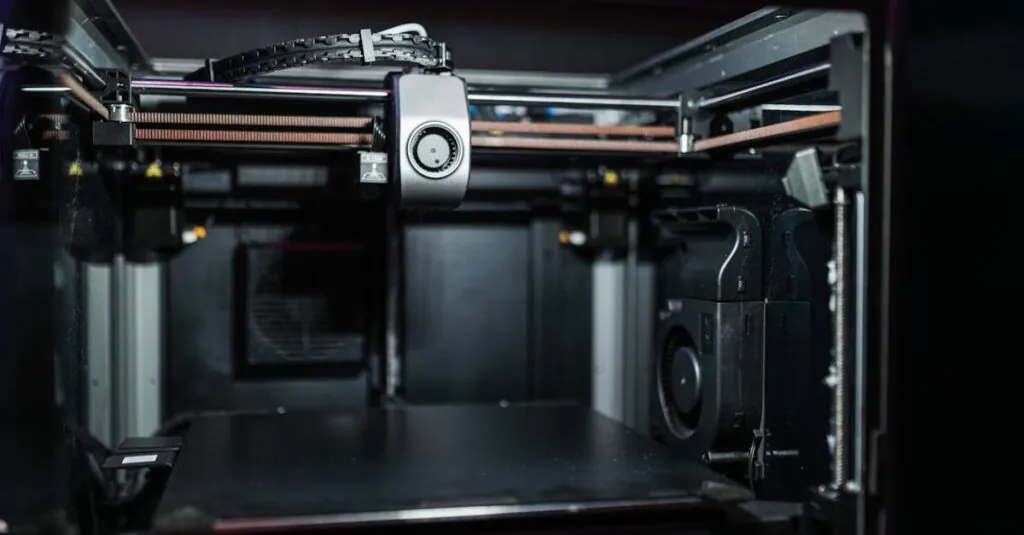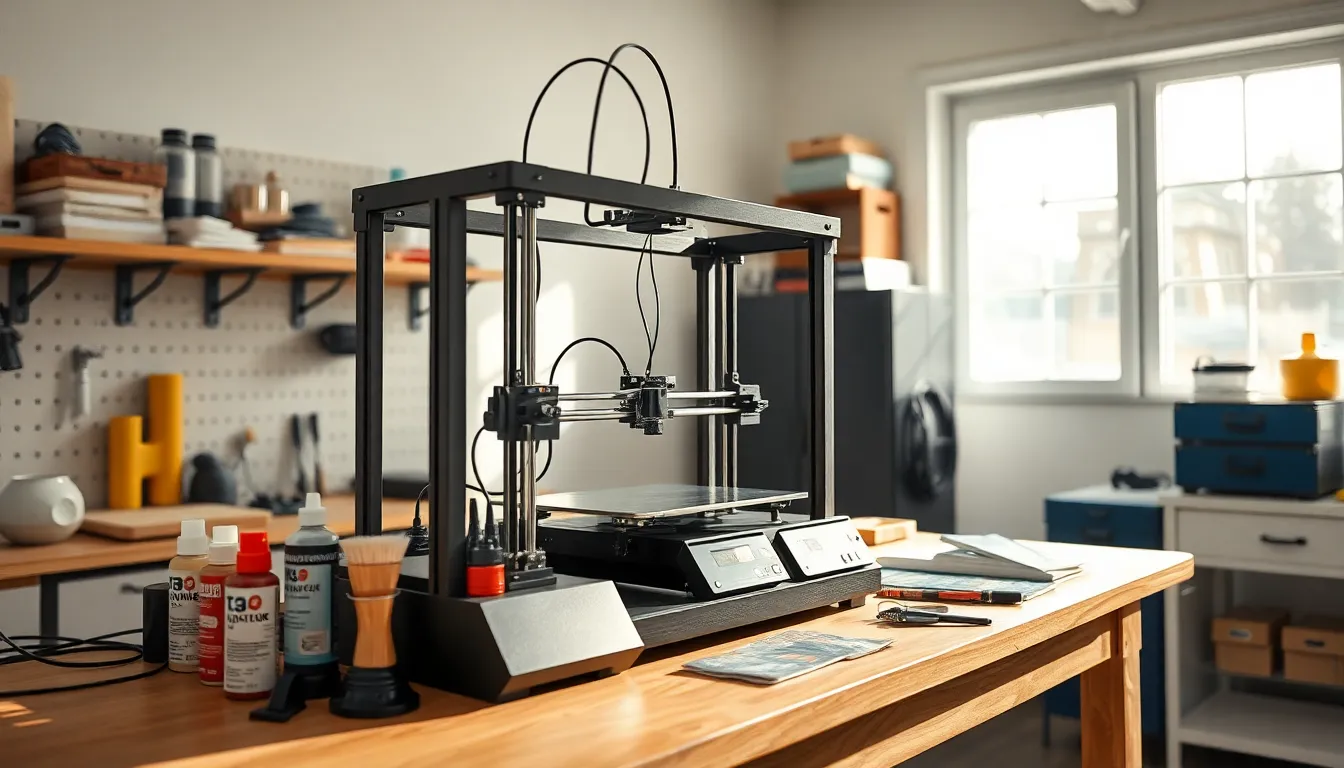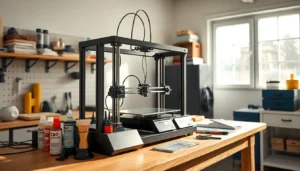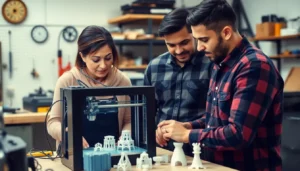In a world where plastic seems to multiply faster than rabbits, 3D printing filament recycling is like a superhero swooping in to save the day. Imagine turning those old, failed prints into fresh, usable filament. It’s not just eco-friendly; it’s a game-changer for makers everywhere.
Picture this: you’ve just printed a masterpiece that looks more like a modern art disaster. Instead of tossing it into the abyss of waste, why not give it a second chance? Recycling filament not only reduces waste but also saves money. Plus, it’s a great conversation starter at your next maker meet-up. Who knew being green could be this much fun?
Table of Contents
ToggleOverview of 3D Printing Filament Recycling
3D printing filament recycling plays a crucial role in addressing plastic waste. This process not only conserves resources but also opens new opportunities for creative projects.
Importance of Recycling Filament
Recycling filament fosters sustainable practices within the 3D printing community. It reduces the demand for new plastic materials, leading to decreased production impact on the environment. Makers benefit from cost savings as using recycled filament typically costs less than purchasing new filament. Creators can also produce unique, customized objects, giving new life to failed prints and excess materials. Engaging in filament recycling encourages a circular economy where creators redefine waste as valuable resources.
Environmental Impact
The environmental implications of 3D printing filament recycling are significant. Recycling helps minimize plastic waste in landfills, with approximately 300 million tons of plastic produced globally each year. By transforming waste into filament, the reduction of landfill pollution becomes evident. Furthermore, using recycled filament decreases the carbon footprint associated with manufacturing new plastic products. Energy conservation also becomes a benefit, as recycling processes generally require less energy than traditional plastic production. Pursuing filament recycling leads to a more sustainable future for the 3D printing industry.
Types of 3D Printing Filaments
Various types of 3D printing filaments serve different purposes, each with unique properties that impact recycling practices.
PLA Filament
PLA filament is derived from renewable resources like cornstarch. It’s biodegradable, making it a popular choice among environmentally conscious creators. This material prints at lower temperatures, facilitating easier processing. When recycled, PLA can retain many of its original characteristics, allowing for new projects with minimal quality loss. The recycling process often involves grinding the filament into pellets, which can then be remelted for future prints. Many makers appreciate PLA for its range of colors and finishes, enhancing the appeal of recycled creations.
ABS Filament
ABS filament is favored for its strength and durability. Its resistance to impact makes it suitable for functional parts and prototypes. However, it’s not biodegradable, which raises sustainability concerns. Recycling ABS requires more energy compared to biodegradable alternatives, but it’s still feasible. First, the filament undergoes mechanical recycling methods like shredding. The resulting pellets can be extruded into new filament. Many in the 3D printing community recognize the necessity of developing better recycling processes for ABS to reduce plastic waste and environmental impact.
PETG Filament
PETG filament combines the advantages of both PLA and ABS, offering strength while remaining easy to print. This material exhibits good chemical resistance, making it ideal for various applications. Recycling PETG is vital, as it helps reduce plastic waste significantly. The recycling process often involves shredding the filament into smaller pieces, which can then be re-extruded into new filament. Many creators find that recycled PETG maintains excellent properties for a range of projects, balancing performance and sustainability. The growing popularity of PETG highlights its importance in a circular economy.
Methods of Filament Recycling
Various methods exist for recycling 3D printing filament, each contributing to the sustainability of the process. These methods include mechanical recycling, chemical recycling, and energy recovery.
Mechanical Recycling
Mechanical recycling involves physically reprocessing used filament into new materials. This method includes shredding failed prints into small flakes before melting them down and extruding new filament. PLA, known for its recycling capabilities, retains properties during this process that make it easy to reuse. Some makers implement mechanical recycling using specialized machines, which streamline the procedure and often provide a cost-effective solution. Reclaimed filament can produce high-quality prints, reducing both waste and the need for virgin plastic.
Chemical Recycling
Chemical recycling offers an alternative approach by breaking down filament into its raw chemical components. This technique allows for a diverse range of polymers, including ABS and PETG, to be recycled effectively. Utilizing processes like depolymerization, plastic waste transforms back into monomers, enabling the production of new filament with minimal loss of quality. Many researchers explore this area, seeking efficient methods that manufacturers can adopt. Such advancements could pave the way for a more sustainable cycling of plastic materials.
Energy Recovery
Energy recovery focuses on extracting energy from non-recyclable or contaminated filament. Incineration, for example, transforms waste into heat energy, which can potentially be harnessed for fuel or electricity. This method plays a crucial role in handling filament that cannot be recycled mechanically or chemically. While not a preferred solution due to emissions, energy recovery is an option to reduce landfill waste. Many facilities that manage waste also integrate this practice, contributing to overall energy efficiency in the industry.
Challenges in 3D Printing Filament Recycling
3D printing filament recycling presents several challenges that impact its effectiveness and adoption within the maker community.
Quality Consistency
Maintaining quality in recycled filament proves difficult due to variations in material properties. Different types of filaments, like PLA, ABS, and PETG, often require distinct processing methods. Inconsistent input materials lead to unpredictable outputs, causing quality fluctuations. These variations can affect the mechanical properties of the final printed objects. Shedding unwanted characteristics during the recycling process presents a significant hurdle. Ensuring reliable performance in recycled filament requires careful monitoring and control strategies throughout the recycling process. Without these measures, confidence in using recycled filament may decline among creators.
Cost of Recycling
The cost of recycling filament can deter makers from engaging in sustainable practices. Initial investments in recycling equipment and technology often present a barrier. Small-scale operations may struggle with the economics of setting up recycling processes compared to purchasing virgin filament. Even when recycling is implemented, operational costs can accumulate from energy use and maintenance. High-quality recycled filament still has to compete with lower-priced virgin alternatives in the market. As a result, affordability plays a critical role in the widespread adoption of filament recycling. Addressing economic constraints may encourage more users to consider sustainable filament options.
Future of 3D Printing Filament Recycling
3D printing filament recycling is set to undergo significant transformations, driven by technological advancements and changing industry dynamics.
Innovations in Recycling Technology
Innovative recycling processes continue to emerge, enhancing the efficiency of filament recovery. New machines enable rapid grinding and pelletizing of used filament, reducing waste and streamlining production. Advanced chemical recycling techniques break down various filament types, including ABS and PETG, into their basic components, making it easier to repurpose them. Furthermore, improvements in quality control technologies help maintain consistent filament properties, ensuring reliability in the finished products. Continuous research in bio-based filaments is also pivotal, as these materials can further simplify the recycling process and minimize the environmental footprint.
Industry Trends
Emerging industry trends reveal a growing inclination towards sustainability among creators and manufacturers. Increasingly, businesses integrate recycled filaments into their supply chains, promoting eco-friendly practices. Awareness campaigns emphasize the environmental benefits of filament recycling, influencing consumer preferences. Collaborative efforts between recycling facilities and 3D printing companies support a circular economy, fostering partnerships to expand recycling capabilities. Market demand for sustainable materials continues to rise, driving innovation and competition among filament producers. Ultimately, these trends point to a future where filament recycling becomes a standard practice within the 3D printing community.
Conclusion
Embracing 3D printing filament recycling is essential for fostering a sustainable future in the maker community. By transforming waste into valuable resources, creators can minimize their environmental impact while enjoying the benefits of unique and customized prints. As technology advances and recycling methods improve, the potential for high-quality recycled filament will only increase.
The shift towards sustainability is not just a trend; it’s a necessary evolution in the 3D printing industry. By prioritizing recycling practices, makers contribute to a circular economy that values resource conservation and environmental responsibility. With continued collaboration and innovation, the future of 3D printing can be both creative and eco-friendly, ensuring that the community thrives while protecting the planet.










